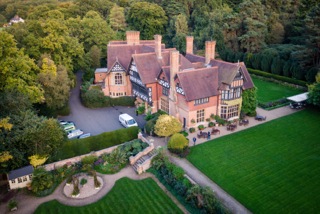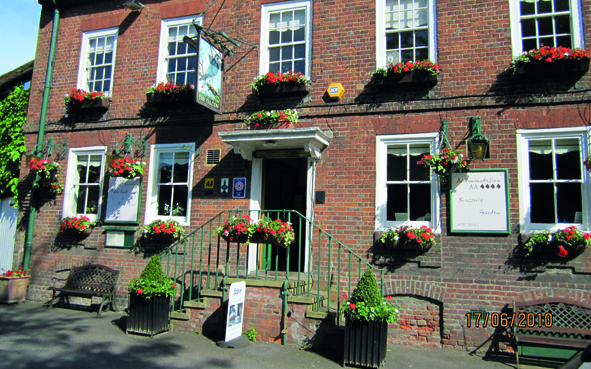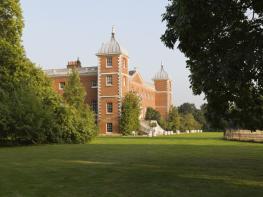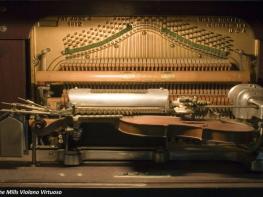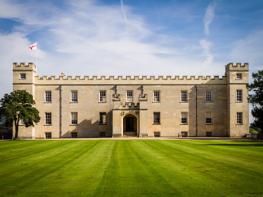Grim’s Dyke Hotel is set in 40 acres of beautiful gardens and tranquil woodlands, yet is just 12…
The highs of Harrow on the Hill

3.5 miles (5.7kms)
About the walk
From a humble start in 1572, when local farmer John Lyon obtained a royal charter, Harrow has become one of the country's best-known boys' schools. During the walk you will tread the same ground as Anthony Trollope and Lord Byron who had very different journeys through life.
Poetic licence
Lord Byron was only 10 years old when he inherited his title in 1798, and he started school at Harrow in 1801. Although his classmates remembered him best for his satire and wit, he could be a sensitive and reflective child – he would sit in the churchyard for hours. 'Spot of my youth, whose hoary branches sigh, Swept by the breeze that fans thy cloudless sky'.
However, by the time he left for Cambridge University in 1805 he had grown into a handsome man and had no shortage of female admirers. These included Lady Caroline Lamb, with whom he had an affair. But Byron also concealed a grave secret – his father had a daughter, Augusta, from a previous marriage. Byron had met Augusta for the first time when he was only 14, but when they met again nine years later, they became constant and very close companions. In due course she became pregnant and gave birth to a daughter. The following year Byron married Annabella Milbanke, but she later left him and rumours of his possible incest with Augusta soon spread. His friends and public turned against him. A deeply embittered Byron left England for Europe, never to return. His mistress, Claire, gave birth to a daughter, Allegra, who is buried in the churchyard of St Mary's. Later, he became involved in the struggle for democracy in Italy and Greece. In 1821 he had his most productive year yet, completing Don Juan and The Vision of Judgement, but he was just 36 years old when he died from a fever in Greece.
A man of letters
School days were not the happiest times of Anthony Trollope's life because a decline in the family fortune prompted a move from a rather grand house in Harrow to a farmhouse in Harrow Weald. After leaving school he joined the General Post Office (GPO), but it wasn't until a transfer to Ireland seven years later that Trollope's career really took off. One of his achievements was to introduce the pillar box to Great Britain. By the time he decided to leave the GPO to concentrate on writing, Trollope was already an accomplished novelist. He had disciplined himself to write from 5.30am until breakfast, after which he left for work. Although his skills weren't recognised until his fourth novel, The Warden (1855), was published, he became a prolific author (47 novels), including the 'Barsetshire' series and The Way We Live Now (1875).
Walk directions
Take the Lowlands Road exit from Harrow on the Hill tube and cross the road into Lansdowne Road. At the top of this keep straight ahead on up the grassy slope in the direction signposted 'The Hill'.
At the top of the slope, turn right along an enclosed footpath. At the end of the path, where it meets the road, turn left, uphill again, along a steep tarmac path beside St Mary's churchyard. At the top, just before turning left to the church, is Byron's Seat.
Leave by the lychgate and turn right, along Church Hill. On the right is The Old Schools – the original school building finished in 1615 and enlarged in 1820. Go down the steps on your left and cross the road to the school library and church. Follow the road left downhill as it swings to the right after the church.
Turn right along Football Lane and continue down Music Hill (passing the Museum of Harrow Life) to reach the playing fields. Follow the tarmac path to the left and turn right along the path between the rugby fields. After the last pitch go left past a line of trees, keep ahead and over a stile then cautiously cross the busy Watford Road.
Pick up the Ducker Footpath opposite and carry on ahead as it passes close to Northwick Park and St Mark's Hospital, before veering to the right. Walk alongside the golf club but keep outside the fence.
After the hospital buildings, emerging beside a playground, turn left along a tarmac path beside a brook, with playing fields to your right. At the end of the path is Northwick Park tube.
Turn left just before the tube station, along a footpath that doubles back again. Follow this as it veers to the right and passes between the buildings of Northwick Park and St Mark's Hospital and the University of Westminster campus. At the end of the footpath turn left. Cross the busy A404 at the traffic lights. Turn right to follow this main road for 100yds (91m) and go through a gate along an enclosed footpath running initially by the side of a pitch-and-putt golf course.
At the end of this long footpath turn right along Peterborough Road, then left to reach Tyburn Lane/Lowlands Road. Harrow on the Hill tube station is on your right.
Additional information
Footpaths, fields and pavements
Hilltop views and buildings of Harrow School
No problems
OS Explorer 173 London North
Pay-and-display in nearby streets (try Lansdowne Road)
Harrow on the Hill Station
WALKING IN SAFETY
Read our tips to look after yourself and the environment when following this walk.
Find out more
Also in the area
About the area
Discover Greater London
Greater London is one of the world’s largest urban areas; 33 boroughs stretching north to Enfield, south to Croydon, east to Havering, west to Hillingdon and with central London at the heart of it all.
Greater London was officially created in 1965, but the boroughs themselves all have their own histories going back much further. Greenwich is home to the Prime Meridian, which all clocks on earth take their time from, while Hounslow contains Heathrow Airport, one of the busiest airports in the world. Greater London contains a multitude of parks and green spaces, from the six Royal Parks (including Richmond Park, Green Park, Hyde Park and Regent’s Park) and other huge open spaces like Hampstead Heath and Clapham Common; to smaller community spaces like Clissold Park in Stoke Newington and Burgess Park in Southwark.
The centre of London has its quiet spaces too, like Coram’s Field by Great Ormond Street, and Camley Street Natural Park, a stone’s throw from King’s Cross and St Pancras. One of the city’s most impressive features is the London Underground. Beginning in 1863 as the Metropolitan Railway, it took commuters into The City from the suburbs of Middlesex. It was the first underground railway in the world, and now consists of 11 lines, 270 stations, and 250 miles (402km) of track. It’s estimated that nearly five million journeys are taken every day, and there are nearly one and a half billion riders each year. At peak times, there are more than 543 trains whizzing around the Capital.
Nearby stays
Restaurants and Pubs
Nearby experiences
Recommended things to do
Why choose Rated Trips?
Your trusted guide to rated places across the UK
The best coverage
Discover more than 15,000 professionally rated places to stay, eat and visit from across the UK and Ireland.
Quality assured
Choose a place to stay safe in the knowledge that it has been expertly assessed by trained assessors.
Plan your next trip
Search by location or the type of place you're visiting to find your next ideal holiday experience.
Travel inspiration
Read our articles, city guides and recommended things to do for inspiration. We're here to help you explore the UK.

